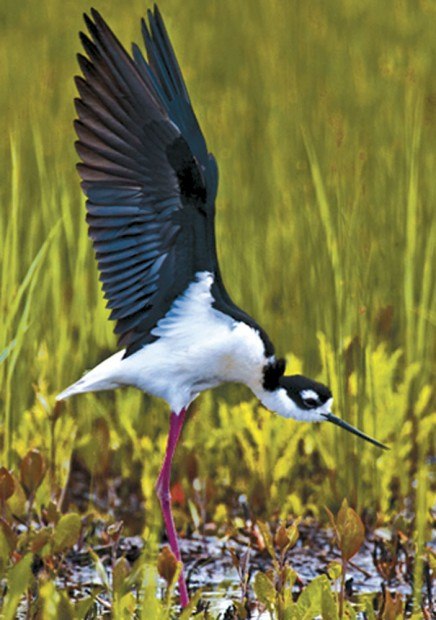THE PLAINS, Va. — Three endemic and endangered Hawaiian waterbirds have increased their populations — with two of those birds showing steep increases in recent years — according to a recent study published in the journal “Population Ecology.” The Hawaiian
THE PLAINS, Va. — Three endemic and endangered Hawaiian waterbirds have increased their populations — with two of those birds showing steep increases in recent years — according to a recent study published in the journal “Population Ecology.”
The Hawaiian common moorhen, the Hawaiian coot, and the Hawaiian black-necked stilt were the subjects of the study; all have been listed under the Endangered Species Act for over 40 years, states a press release from American Bird Conservancy, a nonprofit organization whose mission is to conserve native birds and their habitats throughout the Americas.
The study, which covered the years 1956-2007, was a collaboration between scientists from Tufts University, the University of Connecticut, and the University of Aberdeen. It identified larger population increases on islands where wetlands were being protected — O‘ahu and Kaua‘i — and little or no population increases on islands containing few wetlands and/or less protection — Hawai‘i and Maui.
The study showed that the three waterbirds all had increased in population over the last three decades, with the coot and stilt still showing continuing steep increases, while the moorhen increases had become more modest in recent years. The three birds all reside exclusively in Hawai‘i in low elevation wetlands. Their populations have been impacted by wetland loss, invasive plants, and introduced predators such as rats, cats, dogs, mongoose and bull frogs.
The authors felt that while populations of the three waterbirds were increasing, much more needed to be done to achieve stable and secure populations, including, creating sizeable populations of each bird on multiple islands to guard against a catastrophic loss of a species that inhabits only one island.
Notably, the study offered that, “Increased protection and management, especially on Maui where potential is greatest, would likely result in continued population gains, increasing the potential for meeting population recovery goals” for the birds.
“This study reaffirms what all of us would hope for and, indeed, expect,” said George E. Wallace, ABC’s Vice President for Oceans and Islands. “Management actions are being implemented for these waterbirds and the birds are responding positively. Similarly, at places like Hanawi Natural Area Reserve on Maui and Hakalau Forest National Wildlife Refuge on the island of Hawai‘i , forest birds populations are stable or increasing because of aggressive management. This is the kind of work that is needed to conserve Hawai‘i’s imperiled birds; we just need it on a much grander scale.”
Conclusions from the study were direct: “Coincident with the observed population increases identified in this study, the area of protected wetlands in the Hawaiian Islands has increased since our target species were listed under the ESA. … there has also been an increase in wetland management activities (water management, invasive plant control, introduced predator control, etc.) … smaller wetlands have been created and restored, to increase endangered waterbird numbers. … Given the long-term trend in the Hawaiian Islands of losing wetland habitat from unprotected areas, protected refuges and conservation easements on private land continue to be critically important to recovering the islands’ endangered waterbirds.”
The Hawaiian common moorhen (or ‘alae ‘ula) population is the smallest of the three, numbering as few as 30 in 1970. The total current population is estimated to be in the low 100s. The bird historically inhabited all of the larger islands, but now inhabits only O’ahu and Kaua’i. The 13-inch-long moorhen is dark gray with a black head and neck, and white feathers on its flanks and on its undertail feathers. It has a very distinctive red frontal shield above its yellow-tipped bill. Its legs and feet are greenish.
The Hawaiian coot continues to be found on many of the larger islands and with a population estimate of up to 5,000, it is the most abundant of the three birds but it also has the most variable populations, year to year. Hunting depleted populations in the early 20th Century. It is a little larger than the moorhen at 15 inches with a white bill topped by a frontal shield which is usually white, but can vary from bluish white to yellow to dark blood red. They have white undertail feathers that are seen when swimming or during their courtship displays.
The Hawaiian black-necked stilt is found on Hawai‘i, Kaua‘i, Maui, Molokai, O‘ahu, and Ni‘ihau, and more recently, on Lana‘i. Some reports indicate the bird was common in some locations in the late 1800s but by 1900 had become scarcer. By 1940, only 200 were believed to exist. The most recent survey estimates a population of about 1,500 birds. It is a slender wading bird that grows up to 15 inches in length, with a black back and white forehead, and white below; the female has a tinge of brown on its back. It has very long pink legs and a long black bill.


